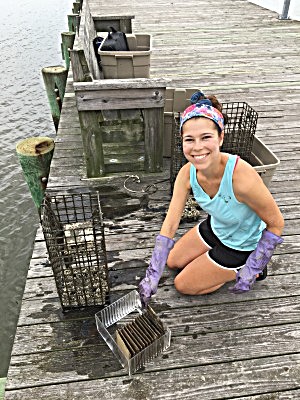
Budding marine biologist, Madeline “Maddie” Farmer, aims to contribute to the health of Maryland Coastal Bays through her research evaluating the distribution and abundance of spat, or oyster larvae. The recent graduate of the University of Maryland Eastern Shore master’s program in Marine, Estuarine-Environmental Sciences hopes her work will help federal and state agencies evaluate the feasibility, scale and location of a restoration effort.
“Maddie definitively identified locations where oyster restoration might work, as well as those areas where it won’t,” said Dr. Bradley Stevens, professor and distinguished research scientist at the NOAA Living Marine Resources Cooperative Science Center at UMES.
Her first interest in the field was inspired by spending summers as a youth vacationing with family in a small cottage by the water in Maine.
“I went to a lobster pound down the road that had a touch tank where I could hold sea cucumbers and hermit crabs,” she said. “I started looking under the seaweed near the dock to make my very own touch tank where I could observe and wonder about marine life.”
Farmer who calls Oakton, Virginia home, took that interest and pursued a bachelor’s in environmental studies with a minor in biology at Randolph-Macon College in Ashland, Virginia. Following graduation, she entered the MEES program at UMES where she has served as president of the UMES student subunit of the American Fisheries Society Tidewater Chapter, was invited to be in the Phi Kappa Phi Honor Society and was awarded the AFS’ Eileen Setzler-Hamilton Scholarship.
Her decision to pursue a career in marine science was solidified through a Research Experience for Undergraduates internship at the Virginia Institute of Marine Science prior to attending graduate school. “The defining moment came as I was working on a winter dredge survey on a boat in the cold of January being intermittently pinched by blue crabs,” Farmer said. “The experience taught me perseverance and exposed me to the physical demands of environmental research. We worked 12-hour days dredging dormant blue crabs from the Chesapeake Bay.”
Farmer also assisted with an Oyster Restoration Ecosystem Services project at VIMS and researched the impact of conspecific odor cues on selective settlement of three species of fiddler crabs at a lower salinity during a REU internship at the Duke University Marine Lab. She would like to build upon the foundation of research skills that she has developed with the help of mentors like Stevens, she said, this summer at an internship at the Smithsonian Environmental Research Center in Edgewater, Maryland, if selected.
“In the meantime, I’m applying for jobs and plan on taking some time to decompress,” Farmer said. “I’ll spend some time with family and friends and join a master’s swim team.”
Gail Stephens, Agricultural Communications, University of Maryland Eastern Shore, School of Agricultural and Natural Sciences, gcstephens@umes.edu., 410-621-3850.

